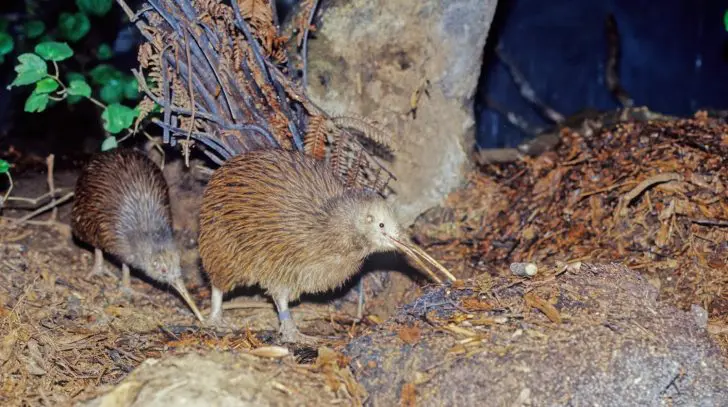| (Copyright 11-25-2024) by Doug Velting (Grand Rapids, Michigan) |
|---|
 Kiwi bird chick and parent in the underbrush: ID 241874046 © Robero Dani | Dreamstime.com Not the small, brown, fuzzy tropical fruit found in the produce section of your neighborhood grocery store. That fruit is called the Kiwifruit, native to eastern Asia. We’re talking about a flightless bird that is about the size of a chicken that is found only in New Zealand. Most birds can fly and have a special ridge on their sternum called a keel, where the flight muscles are attached. But because the kiwi does not fly, this national bird of New Zealand does not need a keel. Their wings are of little use to this bird, as they are only about one inch long and are completely hidden under the feathers. God has created the kiwi with no tail, but it does have strong legs. The leg muscles alone contribute to almost a third of the total weight of the kiwi bird. Their feathers are remarkably different from other birds, looking more like fur. God has created most birds with hollow bones which gives them a lighter weight, which is ideal for flight. But the kiwi bird has heavy solid bones with marrow in them. The kiwi bird has a low body temperature for a bird of only 100° F. This bird lives in the forested areas of their island country and loves steep rugged terrain. The kiwi bird uses its strong leg muscles and claws to dig a burrow for its nest. Most birds are active during the day and sleep at night, but the kiwi bird is mostly nocturnal, resting in its burrow during the day and coming out at night to feed. They travel around their territory eating worms and other insects. God has created this bird of New Zealand with a special “tool” to help it find and eat worms and other insects that lie underground. It is the only bird in the world that has nostrils at the tip of its bill. Using its highly developed sense of smell and sensory pads at the tip of its bill, the kiwi bird will poke its bill in the soil sniffing out worms, grubs, and seeds. If a bit of soil gets sniffed up its nostrils, this bird will simply sneeze it out. This bird will often tear apart rotting logs with its powerful legs and claws to find beetles and their larvae to eat. The kiwi bird has large ear openings, so if it hears danger it can quickly run through the thick underbrush to safety. Then it will turn around with its bill in the air sniffing for danger. The kiwi bird protects the territory it has staked out by patrolling its area every night, leaving smelly droppings to mark its boundaries. This is usually enough to keep other kiwi birds away, but if another kiwi bird does invade its territory, they give out loud shrieks and whistles to scare the intruder away. Their shriek sounds like “kee-wee, kee-wee,” which is how this bird got its name. The Kiwi bird can also grunt, snort, and hiss when angry. Breeding season happens from late winter to early summer. Males will dig a burrow that the female will nest in, but they sometimes use a hollow log instead. The male doesn’t have a beautiful song or colorful feathers to attract a mate, so he will follow the female around hoping she will accept him. If she isn’t interested, she will run away or try to scare him off. The kiwi bird mother lays one egg at a time, but it is a huge one, reaching up to 20 percent of her body weight. This would be like a human mother weighing 120 pounds giving birth to a 24-pound baby. If their egg were in normal proportion to the mother, the kiwi adult female should weigh about 30 pounds instead of their actual weight of around 5 pounds. Since this bird is flightless, it can survive producing an egg of this size and weight. Kiwi bird eggs also contain twice as much yolk as most birds and have natural antibacterial and antifungal elements to them. This feature is important because the damp, underground burrows attract bacteria and fungi. After the female lays the egg, the male incubates for 75 to 85 days. This is a long time of incubation for a bird, made necessary by the unusual size of the egg. The chick does not have an egg tooth, instead it must kick its way out of the shell. As soon as it dries off, the hatchling looks like a miniature adult. The young kiwi lives off the large reserve of yolk in its abdomen for the first few days until it can leave the burrow with its father and search for its own food. The young will stay with the male for about 20 days but may stay within the parents’ territory for a few months more before it finds its own place to live. God’s creativity is limitless, and his unique design of the kiwi bird gives us an added glimpse of his endlessly thoughtful care for all of creation. I will consider all your works and meditate on all your mighty deeds. Psalm 77:12 ———————————————————————————————————————– See Doug Velting’s other articles at: Velting, Doug – The “New” Church of God Messenger (church-of-god-bismarck.org) Reprinted with permission from: The Creation Club https://thecreationclub.com/ ———————————————————————————————————————– |
Views: 2
Sign up to Receive [The "New" Church of God Messenger] weekly newsletter: